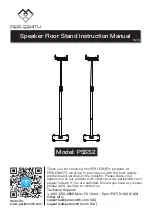
19
After adjusting the kerf boards, release the stopper pin
and raise the handle. Then tighten all the screws
securely.
NOTICE:
•
After setting the bevel angle ensure that the kerf
boards are adjusted properly.
Correct adjustment of
the kerf boards will help provide proper support of the
workpiece minimizing workpiece tear out.
Maintaining maximum cutting capacity
(Fig. 8, 9 & 10)
This tool is factory adjusted to provide the maximum cut-
ting capacity for a 260 mm saw blade.
Unplug the tool before any adjustment is attempted.
When installing a new blade, always check the lower limit
position of the blade and if necessary, adjust it as follows:
First, unplug the tool. Lower the stopper lever to position
the saw blade as shown in the figure. Push the carriage
toward the guide fence fully and lower the handle com-
pletely. Use the socket wrench to turn the adjusting bolt
until the periphery of the blade extends slightly below the
top surface of the turn base at the point where the front
face of the guide fence meets the top surface of the turn
base.
With the tool unplugged, rotate the blade by hand while
holding the handle all the way down to be sure that the
blade does not contact any part of the lower base. Re-
adjust slightly, if necessary.
After adjustment, always return the stopper lever to the
original position by turning it counterclockwise.
WARNING:
•
After installing a new blade and with the tool
unplugged, always be sure that the blade does not
contact any part of the lower base when the handle
is lowered completely.
If a blade makes contact with
the base it may cause kickback and result in serious
personal injury.
Stopper arm (Fig. 11)
The lower limit position of the blade can be easily
adjusted with the stopper arm. To adjust it, rotate the
stopper arm in the direction of the arrow as shown in the
figure. Adjust the adjusting screw so that the blade stops
at the desired position when lowering the handle fully.
Adjusting the miter angle (Fig. 12)
Push the grip so that the cams engages and turn it clock-
wise until it stops. Turn the turn base while pressing
down the lock lever. When you have moved the grip to
the position where the pointer points to the desired angle
on the miter scale, turn the grip 90° counterclockwise to
lock the turn base.
CAUTION:
• After changing the miter angle, always secure the turn
base by turning the grip 90° counterclockwise.
NOTICE:
• When turning the turn base, be sure to raise the handle
fully.
Adjusting the bevel angle (Fig. 13, 14 & 15)
To adjust the bevel angle, loosen the lever at the rear of
the tool counterclockwise. Push the latch lever forward as
shown in the figure fully while supporting the weight of
the saw head so as to release the pressure on the lock
pin.
When tilting the carriage to the right, tilt the carriage to
the left slightly after loosening the lever and press the
releasing button. With the releasing button being
pressed, tilt the carriage to the right.
Tilt the saw blade until the pointer points to the desired
angle on the bevel scale. Then tighten the lever clock-
wise firmly to secure the arm.
When the latch lever is pulled towards the front of the
saw, the saw blade can be locked using positive stops at
the right and left 22.5° and 33.9° angle to the base sur-
face.
When the latch lever is pushed to the back of the saw as
shown in the figure, the saw blade can be locked at any
desired angle within the specified bevel angle range.
CAUTION:
• After changing the bevel angle, always secure the arm
by tightening the lever clockwise.
NOTICE:
• When tilting the saw blade be sure the handle is fully
raised.
• When changing bevel angles, be sure to position the
kerf boards appropriately as explained in the “Position-
ing kerf board” section.
Slide lock adjustment (Fig. 16)
To lock the lower slide pole, pull the lock lever towards
the front of the saw.
To lock the upper slide pole, turn the locking screw clock-
wise.
Switch action
For European countries (Fig. 17)
To prevent the switch trigger from being accidentally
pulled, a lock-off button is provided. To start the tool,
push the lever to the left, press in the lock-off button and
then pull the switch trigger. Release the switch trigger to
stop.
WARNING:
•
Before plugging in the tool, always check to see
that the switch trigger actuates properly and
returns to the “OFF” position when released. Do
not pull the switch trigger hard without pressing in
the lock-off button. This can cause switch break-
age.
Operating a tool with a switch that does not actu-
ate properly can lead to loss of control and serious
personal injury.
A hole is provided in the switch trigger for insertion of
padlock to lock the tool off.
For all countries other than European countries
(Fig. 18)
To prevent the switch trigger from being accidentally
pulled, a lock-off button is provided. To start the tool,
press in the lock-off button and pull the switch trigger.
Release the switch trigger to stop.
WARNING:
•
Before plugging in the tool, always check to see
that the switch trigger actuates properly and
returns to the “OFF” position when released. Do
not pull the switch trigger hard without pressing in
the lock-off button. This can cause switch break-
age.
Operating a tool with a switch that does not actu-
ate properly can lead to loss of control and serious
personal injury.
A hole is provided in the switch trigger for insertion of
padlock to lock the tool off.
Содержание LS1016
Страница 2: ...2 1 2 3 4 5 6 2 2 2 5 6 4 7 8 9 4 3 3 1 009483 010593 009485 009486 009488 001538 ...
Страница 5: ...5 21 22 23 24 25 26 A B 34 35 36 35 37 3 38 39 37 19 1 009493 009494 012597 009483 012591 012592 ...
Страница 12: ...12 75 92 96 009516 ...
Страница 150: ...150 ...
Страница 151: ...151 ...
Страница 152: ...Makita Corporation Anjo Aichi Japan www makita com 884886I995 IDE ...
















































